The best acoustic guitars under $300 are affordable units that are a step above entry-level models. The following list of products allows choosing the item for either a beginner or intermediate player.
In this post, it deals with the dreadnought models that cater to those putting rich and loud tone first since the concert items feature rounded contours and a deeper waist taper. The list of the best acoustic guitars under 300 dollars below also highlights the peculiarities of a small-bodied travel model for on-the-go musicians.
Keep reading to learn about the hybrid electric-acoustic units that are fitted with magnetic or piezoelectric pickup, or a microphone to boost amplification. If someone needs instant and easy access to the upper frets, cutaway units are worth considering. However, some of the models mentioned in the post can combine the benefits of several guitars.
The revision deals with affordable but high-quality instruments to choose the best acoustic guitar under $300 for practice. They have different sizes, necks, and bodies. Besides, they belong to manufacturers that also produce elite units for famous musicians. That’s why we gathered the products that save your budget and, at the same time, meet strict requirements for appearance, reliable construction, tone quality, and convenience of use.
Acoustic Guitar Under $300 Reviews
Fender FA-125
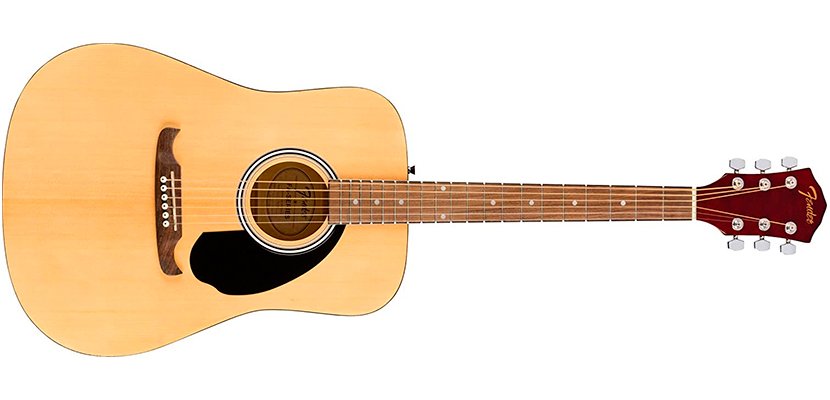
The 6-string Fender FA-125 is a full-sized laminated model with metal strings and a normal C-profile guitar neck made of Eastern mahogany. The item has a spruce top, basswood back, and sides. The black tile prevents the varnish from scratching the ankle during the expressive performance.
It is one of the best acoustic guitars under 300 dollars among dreadnought models in the low-cost range and a win-win solution for beginners and emerging players. The item is easy to press down thanks to the rosewood fingerboard. Both edges of the unit circle have a black binding, which is also visible on the fretboard. The advanced 3+3 headstock is designed with a chrome finish and has closed oil keys. The latter provides stability of the dress once a player has leveled and reshaped the frets.
The sound features warm mids, rich lows, and slightly dirty highs that will become cleaner with the top-notch strings. This economic-grade acoustic model is equipped with the basic die-casting tuners that prevent the guitar from staying out of tune. Besides, it has twenty frets that are quite enough to make a musician happy with plenty of tonal options. The Viking fixed bridge is attached and is known for its capability to ensure stable tension of the strings.
Pros
- The case, clip-on tuner, gig bag, strap, and strings are in the bundle. It also comes with a helpful DVD that explains all of the basics like care, tuning, reading tabs, and playing chords.
- Both left- and right-handed players and can use this model.
Cons
- It is too big for children.
- The guitar suffers from a lack of resonance. It eventually deteriorates and loses its value over time.
Video Fender FA-125
Fender CD-60S
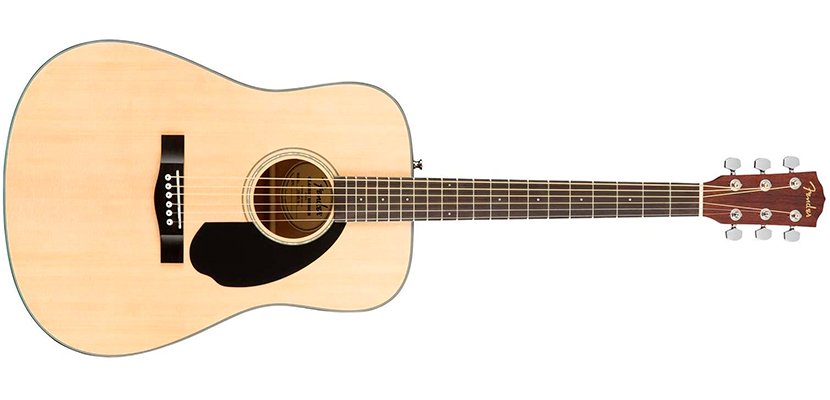
If you specifically want the acoustic guitar under $300 for left-handers, the Fender CD-60S might cater to your preferences. It comes with a solid spruce top, meaning the essential improvement over time, as the wood dries out and enhances resonance. The guitar is smaller than many other full-sized instruments that make it quite suitable for young learners.
The unit has good playability, coming with a hand-friendly profile neck that is trouble-free to hold. The nut has an average height, meaning that the user does not have to press down the strings intensively to get a clean chord. The vintage frets ends have no sharp edges. The item features a dual-action truss rod for stable forward and back adjustments. It also has a rosewood bridge that seems to serve for years.
The Fender CD-60S complies with the requirements of the best 300-dollar acoustic guitar since it delivers a loud and pure buzz-free sound that fills the medium-sized room. It features a lively and well-balanced tone with optimal brightness and warmth, as well as deep bass without the unwanted rattle and hum in D# chord.
The unit comes with a digital tuner and an extra set of “light” strings that are suitable for the beginner’s soft fingertips.
Pros
- The guitar is easy to adjust, and it stays in tune well.
- This model looks well with its chrome die-cast tuners, glossy finish, and mahogany back and sides.
- One more set of Fender strings is in the package.
Cons
- The case is quality enough to avoid scratches on the guitar, but it is too thin unappropriated for traveling.
- There is a single tiny Allen wrench on the guitar to calibrate the truss rod through the soundhole.
Video Fender CD-60S
Yamaha FG800
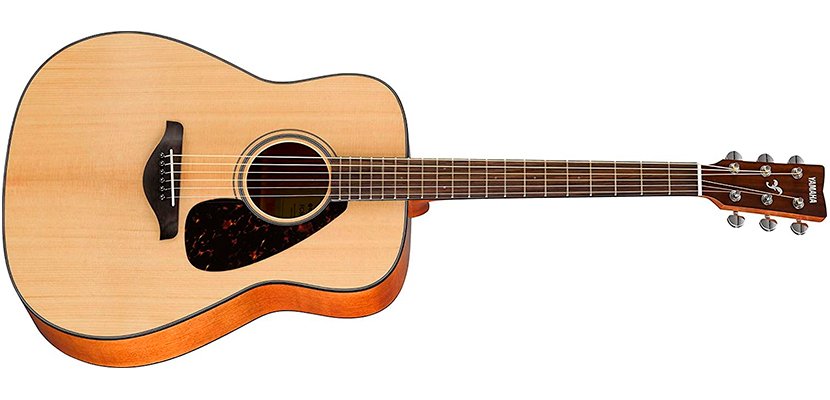
While thinking about the best acoustic guitar under $300, bear in mind the Yamaha FG800. The item has a low weight and an excellent balance between the neck and the body that makes it comfortable to play while standing. The unit is fitted with heavy metal strings, so the novices are better to replace them with lighter strings in the first place.
The item cannot boast the ideal sound by default. The distance of the strings from the fretboard (action) is too high and needs adjustments to produce the required tone and to make the guitar easier to play. Once the guitar is adjusted, a player gets a responsive bass and clear treble. The unit features frets without buzzing, and it intones precisely all the way down the fretboard.
The C-shaped neck has a matte coating that provides a smooth playing even with sweaty hands. Besides, the neck is thin and flat closer to the body that makes both barre chords and individual notes easier to play. The shape of the neck that is closer to the head of the guitar fits in the hand and gives good support for open chord playing.
The instrument doesn’t have the same resonance as a dreadnought guitar because of its smaller size. Still, it is among good acoustic guitars under $300 for young small-statured learners.
Pros
- The construction is flawless without gaps or excess glue around joints.
- The instrument stays in tune for hours.
Cons
- This model is not designed for nylon strings since the neck and body of the guitar need higher tension of metal ones. So, the nylon strings don’t fit in the nut slots.
- It does not come with a hard case.
Video Yamaha FG800
Ibanez AW54OPN
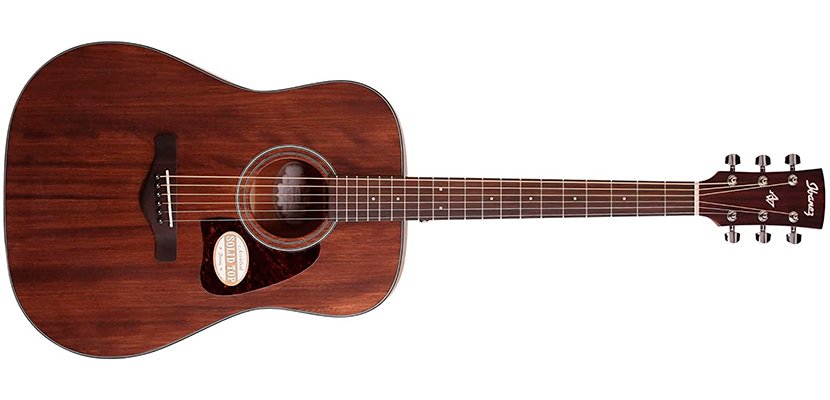
The Ibanez AW54OPN has a full-sized body and the ability to hold tuning for a long time. The unit is a branded artwood model with the design based on the cutting edge woodworking tech. This makes the guitar suitable for people that are into sophisticated bracing techniques.
The unit comes with a solid mahogany top and laminated back and sides. The Ibanez AW54OPN is surprisingly lightweight (4.5 pounds), and it doesn’t have a thick layer of shellac on the top that presents a totally nude wood.
The unit has a thin neck and relatively low weight for a dreadnought that makes it convenient to play. Besides, the width of the neck makes it easier for beginners to learn chords, and its satin surface prevents sweaty hands from sticking and slowing a player down. The sealed chrome die-cast tuners on the headstock have branded bridge pins to facilitate the string replacement.
The action might seem to be high for some players, but it’s not a big deal since the guitar has a truss adjustment wrench to lower the action. The instrument is poised to become the best $300 acoustic guitar due to its loud, bright, and warm sound without buzzing. Besides, it features good loudness that makes the subtle and gentle fingerpicking audible in a noisy environment. Of course, the sound lacks richness and tone nuances, but this drawback is typical for entry-level guitars.
Pros
- The Ivorex II nut and saddle provide the increased harmonic sustain.
- The high-quality open-pore finish hides fingerprints.
- The instrument resonates well.
Cons
- Only 14 frets are onboard.
- The guitar needs frequent tuning.
Yamaha APX600
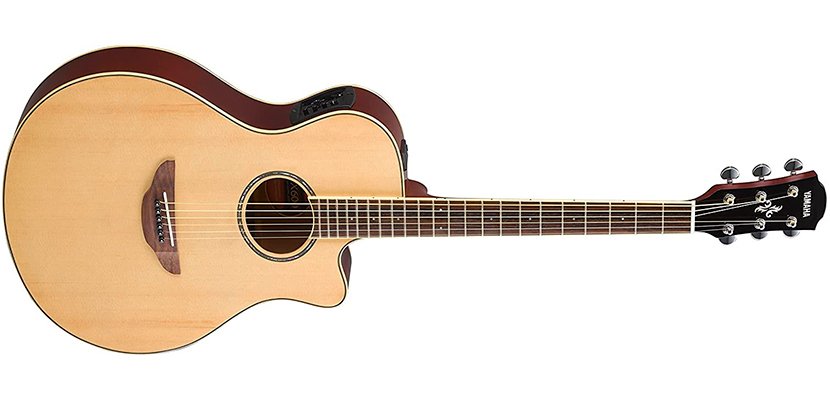
The Yamaha FS800 caters to the requirement of players that are looking for the best acoustic guitar under $300 among the concert-size units. However, the scale of the neck is a full one (not short scale), meaning a bit higher string tension than on a short scale guitar.
If somebody is serious about finding the best acoustic guitar for 300 bucks, they should consider this instrument since it is easy to play and suitable for both young and adult beginners or intermediate players. Although the unit is designed for right-handers, one can easily play with the left hand on by reversing six strings.
The item is a sensitive spruce top guitar that features a highly detailed tone palette. It produces a soft sound that gets extra volume and articulation when a player uses strumming. The unit’s TUSQ saddle ensures clear sound with big open lows and the increased harmonic sustain.
This model comes with the acoustic-electric configuration, meaning the opportunity to upgrade the instrument with a tuner, mid-range frequency control, and 3-band EQ at an additional cost.
Pros
- Due to the size (42.2 x 19.7 x 5 inches), it is a good model to travel with it.
- It has a high-quality matte finish.
- It’s good for both finger-picking and strumming style musicians.
Cons
- There is no strap button on the neck side of the guitar’s body. This makes a player use an included strap that ties to the head.
- The inlay (dot) on the neck at the third fret is absent.
Yamaha APXT2EW
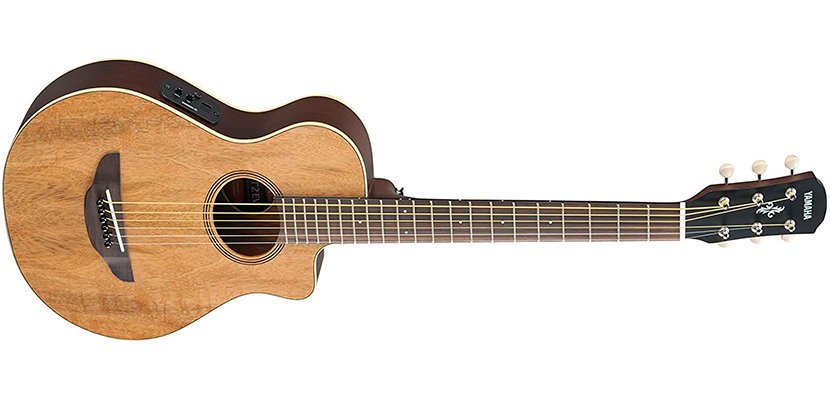
This acoustic-electric guitar under $300 is a 6-string right-handed model that hit the market with the spruce top, curved rosewood fretboard, smooth and responsive neck, and 21 frets. This unit is also remarkable for a dark meranti wood instead of traditional for low-cost items mahogany. It has an adjustable truss rod and a 4-millimeter Allen wrench. Its cutaway 3/4-sized design allows easier access to the lower frets.
The guitar sounds like the high-end model, and its tones are flawless whether it is connected to an amp or a player uses it in the acoustic mode. The Yamaha APXT2EW might be listed as the best acoustic-electric guitar under $300 if a player needs a soprano instrument since it lacks lows and loudness to be used as a regular guitar.
The instrument gets to the top of the best acoustic-electric guitars under $300 since it comes with the branded System 68 contact pickup and active preamp with a built-in tuner. The preamp contributes to a sound’s accuracy while the tuner allows direct connections without extra gear.
Pros
- The action is low enough by default to be played without any additional set-up.
- The unit is resistant to dings, scratches, and might be used as a travel guitar.
- The tuner is sensitive, accurate, and provides fast tuning.
Cons
- It’s impossible to use a nylon bridge since this model’s type of bridge is not made to be used with them.
- Low-quality pegs that cannot keep the guitar tuning.
Fender FA-125CE
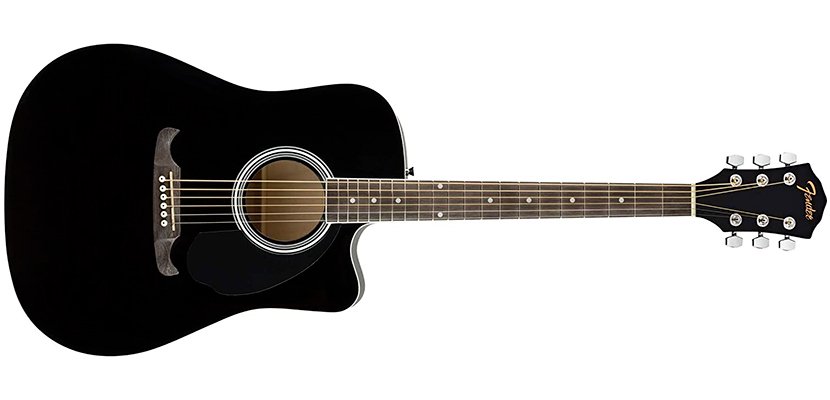
With its versatility, the Fender FA-125CE is among top acoustic-electric guitars under $300. It features a cutaway for seamless access to the upper frets. The unit has both an input jack and a built-in tuner. The latter has just bass and treble controls, but it is quite enough to provide good sound and a decent tone.
The Fender outfitted this model with the active battery-powered pickup. It collects vibrations from the strings and turns them into the powerful and consistent sound coming out of the amp. The action on the strings is comfortable and low. The guitar works in a plugged mode and as a usual acoustic instrument. However, it’s better to connect it to the amp to remove shortcomings in a tone that is audible in the acoustic mode.
The instrument is among the best acoustic-electric guitars under $300 due to its outstanding design. The item is a wood product, with an epoxy gloss finish on the body and neck. Only the top of the guitar is made of laminate spruce. The unit has the branded C-shaped neck to play tirelessly for a long time.
Pros
- The amp cable is in the kit.
- This model is available in different colors (black, natural, and sunburst).
- The product comes in a durable heavy-duty case.
- The guitar has good soundhole projection.
Cons
- The strap is tight and difficult to attach to the guitar.
- The bass, volume, and treble knobs are too small.
Video Fender FA-125CE
Yamaha F325D
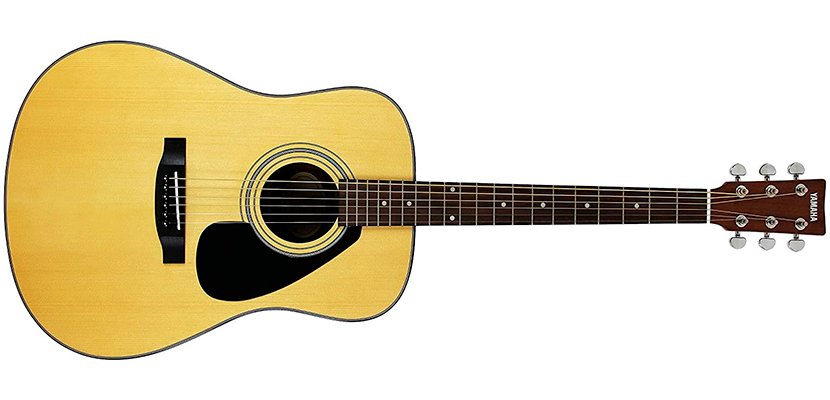
If the musicians are after the best 300-dollar acoustic guitar, the full-sized Yamaha F325D meets their requirements. The Nato neck is securely fastened to the body of the instrument. Its headstock and neck are matte-finished, which is uncommon for most instruments in the low-cost range. This model is made of laminated genuine spruce. The compensated saddle on the bridge ensures accurate intonation. The tuners are solid chrome and hold their tension well that lets a player escape frequent string tuning.
It sounds great with its responsive action and comfortably sized (for average hands) neck, having a rich, deep, and well-balanced tone. However, the neck might seem a bit bulky for a player with small hands. The dreadnought body type adds volume and projection to the sound.
Pros
- It comes as a bundle, with a tuner and other accessories in the package.
- High-quality construction with good bracing provides good acoustics.
- The size of the unit (41.53 x 19.02 x 5.94) makes it unsuitable for traveling and young musicians.
Cons
- This model lacks a cutaway that makes it difficult to play songs with higher notes.
- The guitar is good for strumming, but it doesn’t perform well for advanced techniques.
Video Yamaha F325D
Buyer’s Guide
What to Expect Buying Acoustic Guitars Under $300?
Even the best acoustic guitar under $300 is a decent but not a perfect instrument since it is usually designed for learning and practicing on an amateur level. These models save your budget and feature optimal durability, catchy appearance, and good but not outstanding sound. The latter is possible to enhance with the aid of premium-class strings or an amplifier when it comes to acoustic-electric items.
The entry-level guitars can provide a player with a versatile choice of products for using different playing styles from basic up to advanced techniques.
Neck woods
The manufacturers offer different woods for the guitar necks. Mahogany, maple, and rosewood are the most common materials for the best acoustic and acoustic-electric guitar under 300 dollars. They are more than just a wood itself, but they create tone.
The maple neck is usually designed for electric guitars since it creates a sustainable, bright, and direct tone, while the rosewood contributes to a warmer and rounder one. Besides, rosewood ensures a rich and warm sound, smooth highs, great volume, and resonance. However, it makes guitars a bit heavy. Mahogany is the most widespread material for acoustic guitars since it can provide a good resonance, and let the instrument produce a parlor tangy tone. Besides, it makes the neck stable and prevents it from warping. This wood absorbs vibrations well making the highs less sharp.
Note that the woods’ properties depend on how they combine with the material of a body, including the top, back, and sides. A proper mix of woods enhances the sound and overall quality of the instrument.
Guitar Body Types
Whether the players look for the best acoustic-electric guitar under $300 or a straightforward acoustic model, it’s crucial to consider the guitar’s body shape as a critical selection criterion. The body type affects the sound of the instrument and largely determines the purpose of its use.
Dreadnought (full-sized) acoustic guitars feature louder sounds than their smaller rivals that make them appropriate instruments for playing in a band. However, they might be not comfortable to carry, hold, and play because of a large and broader body. Dreadnought guitars are the good choice to practice strumming; that’s why they are often used to play rock, country, and blues. This guitar body type can create expressive lows and mids that are suitable for the gigantic chords. Besides, these instruments feature good support of the vocal accompaniment.
Concert models are not so loud, but they are smaller and more suitable for the youngest players with small hands. Their compact construction matches finger playing more than strumming. Their soft and gentle sound is great for solo performance. They provide a smooth response from low to high strings.
Travel models are even smaller than concert ones, and they usually have a durable solid mahogany body. It’s easy to transport them to faraway places and store them in a small bedroom.
Jumbo guitars feature great projection being suitable for live performances. They are the largest instruments on the market with lots of resonant space for great volume. High-quality instruments produce a powerful and loud sound. They also have tons of sustain that are perfect for playing slow music.
The auditorium (orchestra) body means a mid-size instrument with a smaller waist but a dreadnought-style or even wider bout. They come with a wide range of well-balanced tone and volume.
Parlor construction means only 12 frets, small width, and elongated lower bout. The guitar has a smaller volume than any other body type; that’s why it is usually played in bands. These instruments provide clarity for upper and high frequencies and versatility to let a player choose any techniques.
Many acoustic guitars come with cutaway regardless of their body type. It’s a good solution if a musician prefers to play in the upper frets since a cutaway makes it easier to access them. For such a style of playing, a cutaway provides a brighter and fuller sound. However, if a guitarist is not going to use upper frets constantly, it’s better to dispense with cutaways since they tend to reduce bass and volume.

Hi everyone! I’m Thomas Moody, also known as Guitarzan.
